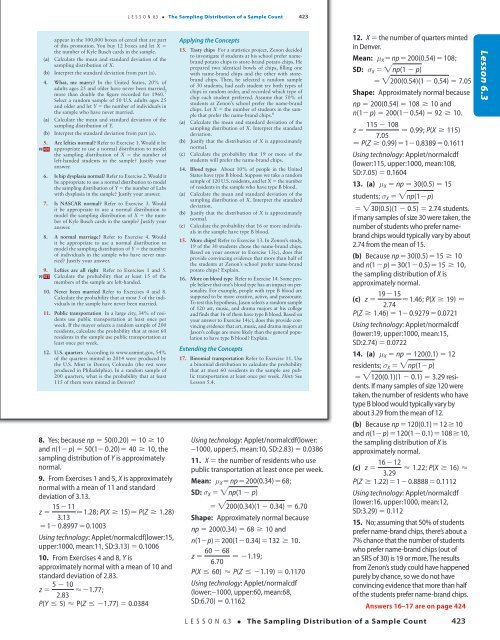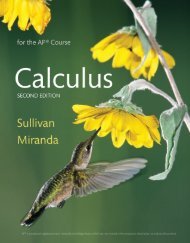SPA 3e_ Teachers Edition _ Ch 6
You also want an ePaper? Increase the reach of your titles
YUMPU automatically turns print PDFs into web optimized ePapers that Google loves.
L E S S O N 6.3 • The Sampling Distribution of a Sample Count<br />
423<br />
18/08/16 5:01 PMStarnes_<strong>3e</strong>_CH06_398-449_Final.indd 423<br />
appear in the 100,000 boxes of cereal that are part<br />
of this promotion. You buy 12 boxes and let X 5<br />
the number of Kyle Busch cards in the sample.<br />
(a) Calculate the mean and standard deviation of the<br />
sampling distribution of X.<br />
(b) Interpret the standard deviation from part (a).<br />
4. What, me marry? In the United States, 20% of<br />
adults ages 25 and older have never been married,<br />
more than double the figure recorded for 1960. 7<br />
Select a random sample of 50 U.S. adults ages 25<br />
and older and let Y 5 the number of individuals in<br />
the sample who have never married.<br />
(a) Calculate the mean and standard deviation of the<br />
sampling distribution of Y.<br />
(b) Interpret the standard deviation from part (a).<br />
5. Are lefties normal? Refer to Exercise 1. Would it be<br />
pg 420 appropriate to use a normal distribution to model<br />
the sampling distribution of X 5 the number of<br />
left-handed students in the sample? Justify your<br />
answer.<br />
6. Is hip dysplasia normal? Refer to Exercise 2. Would it<br />
be appropriate to use a normal distribution to model<br />
the sampling distribution of Y 5 the number of Labs<br />
with dysplasia in the sample? Justify your answer.<br />
7. Is NASCAR normal? Refer to Exercise 3. Would<br />
it be appropriate to use a normal distribution to<br />
model the sampling distribution of X 5 the number<br />
of Kyle Busch cards in the sample? Justify your<br />
answer.<br />
8. A normal marriage? Refer to Exercise 4. Would<br />
it be appropriate to use a normal distribution to<br />
model the sampling distribution of Y 5 the number<br />
of individuals in the sample who have never married?<br />
Justify your answer.<br />
9. Lefties are all right Refer to Exercises 1 and 5.<br />
pg 421 Calculate the probability that at least 15 of the<br />
members of the sample are left-handed.<br />
10. Never been married Refer to Exercises 4 and 8.<br />
Calculate the probability that at most 5 of the individuals<br />
in the sample have never been married.<br />
11. Public transportation In a large city, 34% of residents<br />
use public transportation at least once per<br />
week. If the mayor selects a random sample of 200<br />
residents, calculate the probability that at most 60<br />
residents in the sample use public transportation at<br />
least once per week.<br />
12. U.S. quarters According to www.usmint.gov, 54%<br />
of the quarters minted in 2014 were produced by<br />
the U.S. Mint in Denver, Colorado (the rest were<br />
produced in Philadelphia). In a random sample of<br />
200 quarters, what is the probability that at least<br />
115 of them were minted in Denver?<br />
8. Yes; because np = 50(0.20) = 10 $ 10<br />
and n(1− p) = 50(1− 0.20)= 40 ≥ 10, the<br />
sampling distribution of Y is approximately<br />
normal.<br />
9. From Exercises 1 and 5, X is approximately<br />
normal with a mean of 11 and standard<br />
deviation of 3.13.<br />
15 − 11<br />
z = ≈ 1.28; P(X ≥ 15)≈ P(Z ≥ 1.28)<br />
3.13<br />
= 1− 0.8997 = 0.1003<br />
Using technology: Applet/normalcdf(lower:15,<br />
upper:1000, mean:11, SD:3.13) 5 0.1006<br />
10. From Exercises 4 and 8, Y is<br />
approximately normal with a mean of 10 and<br />
standard deviation of 2.83.<br />
z = 5 − 10<br />
2.83 ≈ −1.77;<br />
P(Y ≤ 5) ≈ P(Z ≤ −1.77) = 0.0384<br />
Applying the Concepts<br />
13. Tasty chips For a statistics project, Zenon decided<br />
to investigate if students at his school prefer namebrand<br />
potato chips to store-brand potato chips. He<br />
prepared two identical bowls of chips, filling one<br />
with name-brand chips and the other with storebrand<br />
chips. Then, he selected a random sample<br />
of 30 students, had each student try both types of<br />
chips in random order, and recorded which type of<br />
chip each student preferred. Assume that 50% of<br />
students at Zenon’s school prefer the name-brand<br />
chips. Let X 5 the number of students in the sample<br />
that prefer the name-brand chips. 8<br />
(a) Calculate the mean and standard deviation of the<br />
sampling distribution of X. Interpret the standard<br />
deviation.<br />
(b) Justify that the distribution of X is approximately<br />
normal.<br />
(c) Calculate the probability that 19 or more of the<br />
students will prefer the name-brand chips.<br />
14. Blood types About 10% of people in the United<br />
States have type B blood. Suppose we take a random<br />
sample of 120 U.S. residents, and let X 5 the number<br />
of residents in the sample who have type B blood.<br />
(a) Calculate the mean and standard deviation of the<br />
sampling distribution of X. Interpret the standard<br />
deviation.<br />
(b) Justify that the distribution of X is approximately<br />
normal.<br />
(c) Calculate the probability that 16 or more individuals<br />
in the sample have type B blood.<br />
15. More chips! Refer to Exercise 13. In Zenon’s study,<br />
19 of the 30 students chose the name-brand chips.<br />
Based on your answer to Exercise 13(c), does this<br />
provide convincing evidence that more than half of<br />
the students at Zenon’s school prefer name-brand<br />
potato chips? Explain.<br />
16. More on blood type Refer to Exercise 14. Some people<br />
believe that one’s blood type has an impact on personality.<br />
For example, people with type B blood are<br />
supposed to be more creative, active, and passionate.<br />
To test this hypothesis, Jason selects a random sample<br />
of 120 art, music, and drama majors at his college<br />
and finds that 16 of them have type B blood. Based on<br />
your answer to Exercise 14(c), does this provide convincing<br />
evidence that art, music, and drama majors at<br />
Jason’s college are more likely than the general population<br />
to have type B blood? Explain.<br />
Extending the Concepts<br />
17. Binomial transportation Refer to Exercise 11. Use<br />
a binomial distribution to calculate the probability<br />
that at most 60 residents in the sample use public<br />
transportation at least once per week. Hint: See<br />
Lesson 5.4.<br />
18/08/16 5:01 PM<br />
Using technology: Applet/normalcdf(lower:<br />
−1000, upper:5, mean:10, SD:2.83) 5 0.0386<br />
11. X 5 the number of residents who use<br />
public transportation at least once per week.<br />
Mean: m X = np = 200(0.34) = 68;<br />
SD: s X = "np(1 − p)<br />
= "200(0.34)(1 − 0.34) = 6.70<br />
Shape: Approximately normal because<br />
np = 200(0.34) = 68 ≥ 10 and<br />
n(1−p) = 200(1− 0.34) = 132 ≥ 10.<br />
60 − 68<br />
z = ≈ −1.19;<br />
6.70<br />
P(X ≤ 60) ≈ P(Z ≤ −1.19) = 0.1170<br />
Using technology: Applet/normalcdf<br />
(lower:−1000, upper:60, mean:68,<br />
SD:6.70) 5 0.1162<br />
12. X 5 the number of quarters minted<br />
in Denver.<br />
Mean: m X = np = 200(0.54) = 108;<br />
SD: s X = "np(1 − p)<br />
= "200(0.54)(1 − 0.54) = 7.05<br />
Shape: Approximately normal because<br />
np = 200(0.54) = 108 ≥ 10 and<br />
n(1− p) = 200(1− 0.54) = 92 ≥ 10.<br />
115 − 108<br />
z = ≈ 0.99; P(X ≥ 115)<br />
7.05<br />
≈ P(Z ≥ 0.99) = 1− 0.8389 = 0.1611<br />
Using technology: Applet/normalcdf<br />
(lower:115, upper:1000, mean:108,<br />
SD:7.05) 5 0.1604<br />
13. (a) m X = np = 30(0.5) = 15<br />
students; s X = "np(1− p)<br />
= "30(0.5)(1 − 0.5) = 2.74 students.<br />
If many samples of size 30 were taken, the<br />
number of students who prefer namebrand<br />
chips would typically vary by about<br />
2.74 from the mean of 15.<br />
(b) Because np = 30(0.5) = 15 ≥ 10<br />
and n(1 − p) = 30(1 − 0.5) = 15 ≥ 10,<br />
the sampling distribution of X is<br />
approximately normal.<br />
19 − 15<br />
(c) z = ≈ 1.46; P(X ≥ 19) ≈<br />
2.74<br />
P(Z ≥ 1.46) = 1− 0.9279 = 0.0721<br />
Using technology: Applet/normalcdf<br />
(lower:19, upper:1000, mean:15,<br />
SD:2.74) 5 0.0722<br />
14. (a) m X = np = 120(0.1) = 12<br />
residents; s X = "np(1− p)<br />
= "120(0.1)(1 − 0.1) = 3.29 residents.<br />
If many samples of size 120 were<br />
taken, the number of residents who have<br />
type B blood would typically vary by<br />
about 3.29 from the mean of 12.<br />
(b) Because np = 120(0.1) = 12 $ 10<br />
and n(1− p) = 120(1 − 0.1) = 108 $ 10,<br />
the sampling distribution of X is<br />
approximately normal.<br />
16 − 12<br />
(c) z = ≈ 1.22; P(X ≥ 16) ≈<br />
3.29<br />
P(Z ≥ 1.22) = 1 − 0.8888 = 0.1112<br />
Using technology: Applet/normalcdf<br />
(lower:16, upper:1000, mean:12,<br />
SD:3.29) 5 0.112<br />
15. No; assuming that 50% of students<br />
prefer name-brand chips, there’s about a<br />
7% chance that the number of students<br />
who prefer name-brand chips (out of<br />
an SRS of 30) is 19 or more. The results<br />
from Zenon’s study could have happened<br />
purely by chance, so we do not have<br />
convincing evidence that more than half<br />
of the students prefer name-brand chips.<br />
Answers 16–17 are on page 424<br />
L E S S O N 6.3 • The Sampling Distribution of a Sample Count 423<br />
Lesson 6.3<br />
Starnes_<strong>3e</strong>_ATE_CH06_398-449_v3.indd 423<br />
11/01/17 3:55 PM




